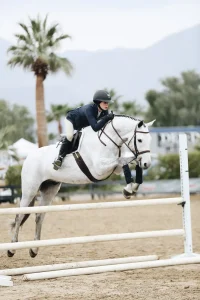 What is Vaulting?
What is Vaulting?
Vaulting combines dance and gymnastics on the back of a moving horse. Vaulting can be used to achieve therapeutic and learning outcomes yet can also be chosen as a leisure activity or a sport. Within the sport of vaulting, you can compete as an individual, a pair (pas-de-deux) or as a squad performing movements together on the horse.
Although you can vault as an individual, this is predominantly a team activity involving the vaulter/s, the lunger and the horse. Vaulting also involves rhythm work on the ground and stationary barrel work. The barrel acts as a surrogate horse to allow vaulters to practice and gain confidence performing exercises before they progress onto the back of a moving horse, thus also supporting the horse’s welfare.
Various movements ranging in complexity can be undertaken during vaulting yet there are seven that are foundational to vaulting, these include vaulting on, basic seat, flag, mill, scissors, stand, and flank (dismount).
Vaulting horses wear a surcingle with two handles that are used by the vaulters to hold onto for certain exercises and two loops (cossack stirrups) either side for the vaulter’s feet to allow them to perform various stands or hanging movements over the back or the sides of the horse. A back pad is used to protect the horse’s back. The horse wears a bridle and side reins. The lunge line is the connection between the horse and the lunger. The lunger will carry a lunging whip which is necessary for communicating with the horse.
The vaulting horse must be well trained with a high level of obedience and a flowing and balanced canter. The horse must also have a calm and consistent temperament and a durable conformation to work on a repetitive circle.
In 1983, Vaulting became internationally recognised by the International Federation for Equestrian Sports (FEI). British Equestrian Vaulting (BEV) and Riding for the Disabled (RDA) both have coaching pathways, see links below for details, RDA also have a vaulting certificate for those who do not wish to complete the coaching pathway.
British Equestrian Vaulting Coaching Pathway:
http://britishvaulting.org/wp-content/uploads/2019/05/BEV-Summary-Coaching-Qualifications.pdf
Riding for the Disabled Coaching Pathway and Vaulting Certificate:
https://www.myrda.org.uk/runningyourgroup/vaulting/
